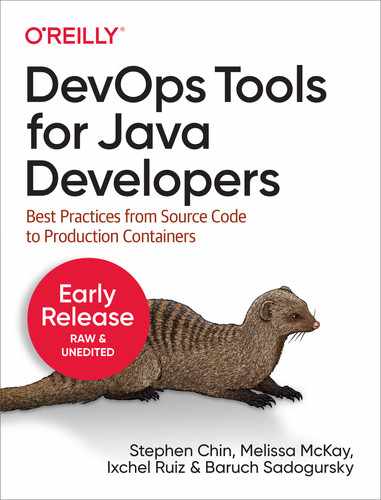With the rise of DevOps, low-cost cloud computing, and container technologies, the way Java developers approach development today has changed dramatically. This practical guide helps you take advantage of microservices, serverless, and cloud native technologies using the latest DevOps techniques to simplify your build process and create hyperproductive teams. Stephen Chin, Melissa McKay, Ixchel Ruiz, and Baruch Sadogursky help you evaluate an array of options. The list includes source control with Git, build declaration with Maven and Gradle, CI/CD with CircleCI, package management with Artifactory, containerization with Docker and Kubernetes, and much more. Whether you're building applications with Jakarta EE, Spring Boot, Dropwizard, MicroProfile, Micronaut, or Quarkus, this comprehensive guide has you covered.
Table of Contents
- 1. DevOps for (or Possibly Against) Developers
- DevOps is an entirely invented concept, and the inventors came from the Ops side of the equation
- Exhibit #1: The Phoenix Project
- Exhibit #2: The DevOps Handbook
- Google It
- What Does It Do?
- State of the Industry
- What Constitutes Work?
- If We’re Not About Deployment and Operations, Then Just What Is Our Job?
- Just What Does Constitute Done?
- Rivalry?
- More Than Ever Before
- Volume and Velocity
- Done and Done
- Fly Like a Butterfly…
- Integrity, Authentication, and Availability
- Fierce Urgency
- The software industry has fully embraced DevOps
- Making It Manifest
- We all got the message
- 2. The System of Truth
- 3. Dissecting the Monolith
- 4. Continuous Integration
- 5. Package Management
- Why build-it-and-ship-it is not enough
- It’s all about metadata
- What’s metadata?
- Determining the metadata
- Capturing metadata
- Writing the metadata
- Dependency management basics for Apache Maven & Gradle
- Dependency management with Apache Maven
- Dependency management with Gradle
- Dependency management basics for containers
- Artifact Publication
- Publishing to Maven Local
- Publishing to Maven Central
- Publishing to Sonatype Nexus
- Publishing to JFrog Artifactory
- 6. Securing Your Binaries
- Supply Chain Security Compromised
- What Happened at SolarWinds?
- Security from the Vendor Perspective
- Security from the Customer Perspective
- The Full Impact Graph
- Securing your DevOps infrastructure
- The Rise of DevSecOps
- The Role of SREs in Security
- Static and Dynamic Security Analysis
- Static Application Security Testing
- Disadvantages of the SAST approach
- Dynamic Application Security Testing
- Comparing SAST and DAST
- The Common Vulnerability Scoring System
- CVSS Basic Metrics
- CVSS Temporal Metrics
- CVSS Environmental Metrics
- CVSS Summary
- Extent of Security Scanning
- Time to Market
- Make or Buy
- One-time and Recurring Efforts
- How much is enough?
- Compliance versus Vulnerabilities
- Compliance Issues: Singular Points in your Full-Stack
- Vulnerabilities: Can be Combined into Different Attack-Vectors
- Vulnerabilities: Timeline from Inception Through Production Fix
- Test Coverage is your Safety-Belt
- Security scanning as a Promotion Quality Gate
- Fit with Project Management Procedures
- Implementing Security with the Quality Gate Method
- Risk Management in Quality Gates
- Practical Applications of Quality Management
- Shift Left to the CI and the IDE
- Not All Clean Code is Secure Code
- Effects on Scheduling
- The Right Contact Person
- Dealing with Technical Debt
- Advanced Training on Secure Coding
- Milestones for Quality
- The Attacker’s Point of View
- Methods of Evaluation
- Be Aware of Responsibility
- 7. Mobile Workflows
- 8. Continuous Deployment Patterns and Antipatterns
- Why Everyone Needs Continuous Updates
- User Expectations on Continuous Updates
- Security Vulnerabilities Are the New Oil Spills
- Getting Users to Update
- Case Study: Java Six Month Release Cadence
- Case Study: iOS App Store
- Continuous Uptime
- Case Study: Cloudflare
- The Hidden Cost of Manual Updates
- Case Study: Knight Capital
- Continuous Update Best Practices
